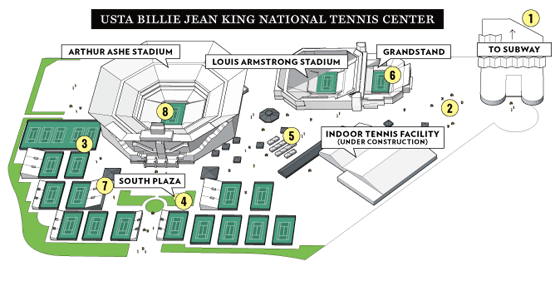
Getting there: The 7 train (1) generally takes 35 minutes to crawl from Grand Central to the National Tennis Center. During the Open, the LIRR runs special service to Shea Stadium; from Penn Station, that trip takes just sixteen minutes.
Getting in: If you don’t bring a bag at all, you use the express security line (2). The regular line can get crushingly long at peak hours, like right before the evening session.
What to buy: A grounds pass for the day is $45 and allows you to roam everywhere and see all the matches, except the ones that take place inside Arthur Ashe Stadium; reserved seating there starts at $60 per session. A pass for the entire Open, with reserved seats in the lower promenade of Arthur Ashe, will run you $1,703. You want parking with that? That’ll be an extra $300.
When to go: The early rounds are a tennis orgy, with dozens of matches going on simultaneously. If it rains one day and a lot of matches are canceled, make sure to go the following day, as the pileup of matches is likely to result in top-ranked players’ appearing on outer courts. Also, the qualifying tournament, which runs from August 21 to 24, is free— a good chance to familiarize yourself with the place and to see fiercely contested matches between players desperate to bust out of the bush leagues.
How to find good matches on the outer courts: Look for people with all-access passes marked H. Chances are they’re tennis fanatics and might have a useful piece of intel to share with you about the day’s most intriguing matchups.
Family drama! Juniors matches are also held during the Open, and they can be riveting. It’s especially fun to pick out the parents and watch the match through their facial expressions and gesticulations.
McEnroe drama! The practice courts are tucked behind Arthur Ashe, and they are another great place to see players up close (3) and marvel at the perfection of their strokes. John McEnroe has been known to go out there and hit during the tournament, and, yes, apparently he does lose his temper if he’s not playing well.
Should you eat? If you’re going to be there all day, you’ll have to eat, and you’re not permitted to bring in your own food. The offerings in the South Plaza (4) are usually a little less crowded than the main food village that you pass through when you walk in from the east entrance (where the train is). The food, though pricey, is not bad, and it can be worth venturing beyond hot dogs. Sports Illustrated writer Jon Wertheim recommends the fish tacos. If you must use one of the full-service, sit-down places, the Cuban-themed Mojitos is the place to go.
The water strategy: The price of bottled water has caused consternation in the past, but the National Tennis Center proudly boasts that it has 33 working water fountains, and nobody will look at you funny if you fill up your own bottle.
The vodka strategy: Among the many branding events of the Open, Grey Goose is serving a cocktail called the Honey Deuce (5), “garnished with frozen honeydew-melon balls to emulate the look of tennis balls.“
Tired of walking around? Park it at the Grandstand court (6), where there’s some shade, no reserved seating, and marquee matchups. A throwback to simpler tennis times.
How to see many matches at one time: Last year, American Express handed out free radios to its cardholders at the Open, which they could use to listen to the match announcers. This year, cardholders also get free mini-televisions, on which they can watch the live feed from six courts. To further coddle its cardholders, American Express is offering free pedicab service from the subway stop. Good luck beating out the old ladies for one of those.
How to see many matches at one time the old-fashioned way: From the perfectly decent top bleachers at Court 7 (7) you can also see Courts 6, 8, 9, and 10. From the top seats of Court 11 you can see 12, 13, 14, and 15.

Back in Manhattan: Giant-screen televisions will once again be set up in Madison Square Park and Rockefeller Center, showing all the big matches.
Party with the players! The official hotels for the men are the W on Lexington and the Parker Meridien. Chances are Roger Federer won’t be at the bar, but your favorite Estonian mixed-doubles team might be there.
The Grand Finale: On Sunday, September 9, the men’s singles final and the women’s doubles final are held at Arthur Ashe Stadium (8). It will cost you. On StubHub.com, nosebleed tickets are going for about $200 and up; courtside tickets can be had for up to $8,950. Prices will undoubtedly fluctuate depending on whether the Federer-Nadal final that everybody is hoping for actually materializes. If you’re desperate to go, we advise figuring out if you have any friends who work at JPMorgan or American Express, as they control the most luxury-box space.
A Player’s Advice for Spectators

From Dmitry Tursunov, who describes himself as “a pretty good unknown player to watch” and is currently ranked 26th in the world:
“First and foremost sunscreen and a hat! Some comfortable clothing will help out as well, because you might end up spending a few hours in the sun and it might not be the best idea to wear heels and a designer leather jacket or an expensive suit. Prepare yourself for a huge line to the bathroom and, for the love of Jesus, turn your cell phones to silent mode!”
Photo: Alex Livesey/Getty Images